Nobody puts bacon in the corner! But everybody should put bacon in the oven. If you’re looking for the best way to cook bacon, look no further than a sheet pan. Cooking bacon in the oven is the easy, hands-free way to guarantee it’s evenly cooked and crisped to perfection. It’s also the best way to cook more bacon for more people.
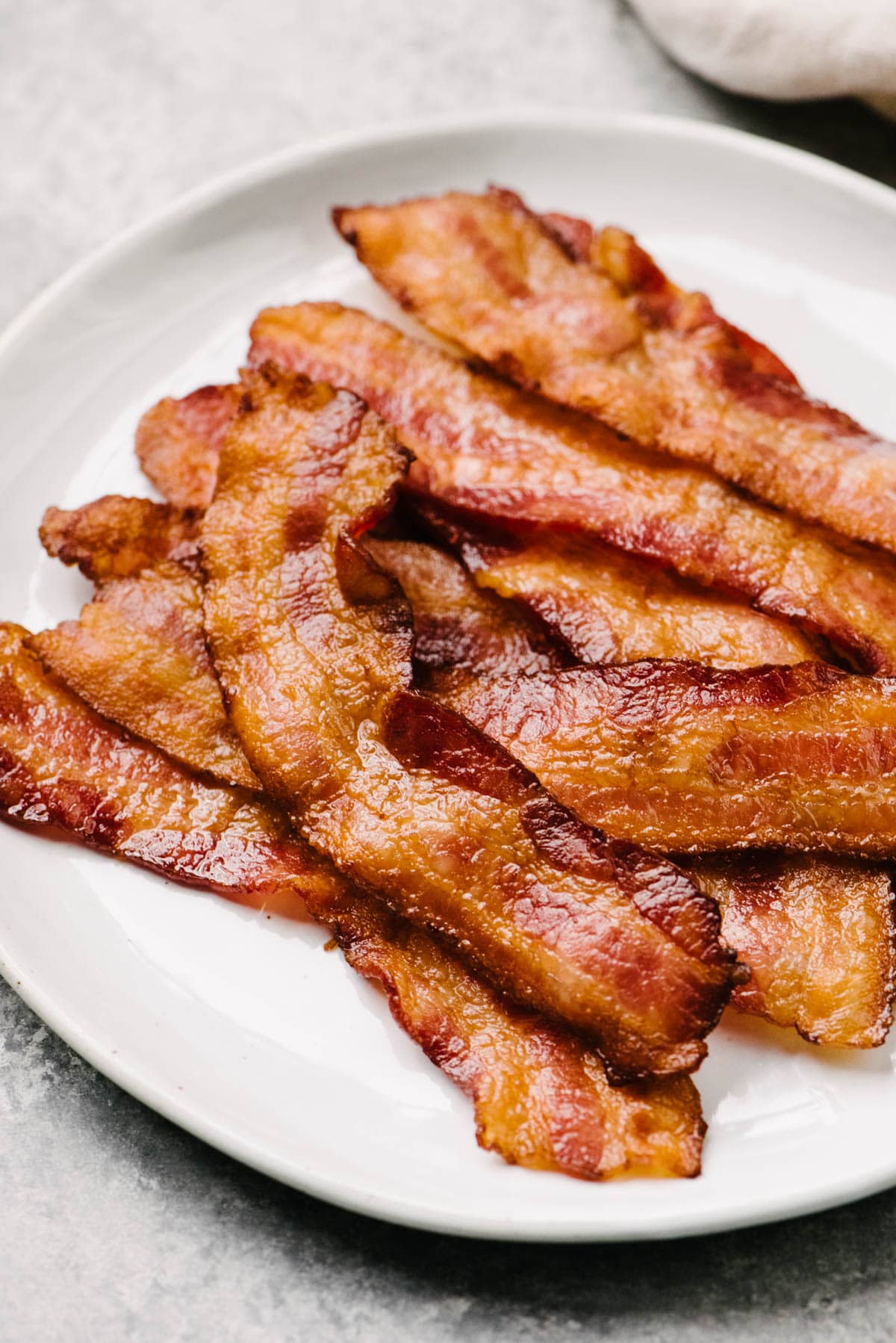
Jump to:
Cooking bacon is a labor of love. It’s greasy and unwieldy and gone far too quickly. However, the reward is ten times worth the risk and I’ll take whatever bacon I can get.
Now, I’m a big fan of going “whole hog,” so a lot of my best bacon recipes not only call for the meat, but also for the fat: crispy corn fritters with bacon that are also fried in bacon fat, breakfast fried rice with bacon crumbles stir fried in (you guessed it) bacon fat, and one of my personal faves, summertime tomato salad with warm bacon vinaigrette.
The preparations for those bacon recipes are fairly dependent on the use of a skillet, but for others, well, there’s an even better way to cook bacon. Frankly, I’d argue it’s the best way to cook bacon if you truly love bacon.

Oven Bacon is the Best Bacon
The headlines says it all. I don’t know a single soul who, after cooking bacon in the oven for the first time, doesn’t exclaim “Why didn’t I do this sooner?!”
First and foremost, it’s easier. As previously stated, cooking bacon is obnoxious as hell. (Like, could you imagine spending any time peeling shrimp or picking crabs if they weren’t delicious? The protein wouldn’t be worth the trouble.) But oven bacon? So much simpler since it’s hands-free, plus it’s cleaner and safer!
Just arrange your bacon on a baking sheet, pop it in the oven, turn once, and done! Stovetop splatter is a thing of the past, along with grease speckles on your clothes and teeny tiny excruciating bacon burns.
It’s also far superior when you’re cooking for a crowd. I’ve gotten up to 10 slices on one sheet. That’s 10 whole slices, cooking all at once, done all at once. And if you need more? Use 2 sheet pans! So yeah, it’s great if you’re feeding a crowd…or just feeding yourself a ton of bacon.
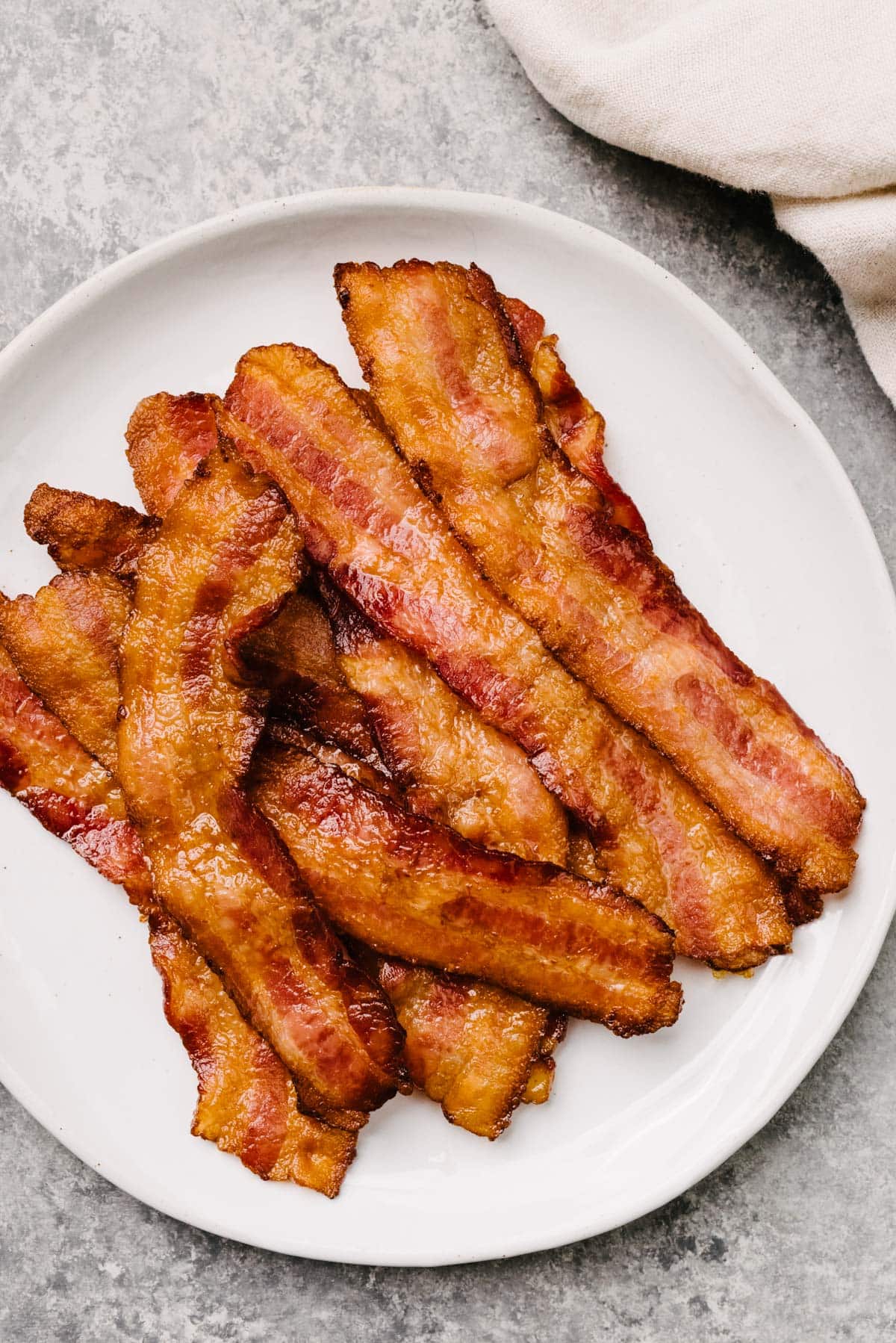
Our Best Tip for the Best Oven Bacon!
Cooking bacon in the oven isn’t difficult – it’s actually one of the easiest bacon recipes you can learn how to cook! But if you skip this ONE step, you’ll wind up with bacon that isn’t cooked evenly, resulting in some crispy bites, some fatty bites, and some burnt bites.
Pro-tip: Start the bacon in a cold oven!
When you cook bacon in a skillet on the stovetop, conventional wisdom dictates that you always place the bacon in a cold skillet, then gently start heating it. This allows the fat to render out of the bacon slowly and evenly, resulting in perfectly cooked slices each and every time.
The same logic applies to oven bacon! When you place bacon in a cold oven and allow it to heat up gently, the fat will render (aka “cook out”) at the same rate, creating crispy strips of bacon from end-to-end.
Want proof? Check out these images! On the left, the bacon was placed in a heated 400°F oven. The bacon on the left was started in a cold oven that was then heated to 400°F.
To be clear – the bacon on the left isn’t bad – it’s very tasty! But it’s clearly unevenly cooked, with very crispy ends and a softer center. The bacon on the right is evenly cooked throughout.
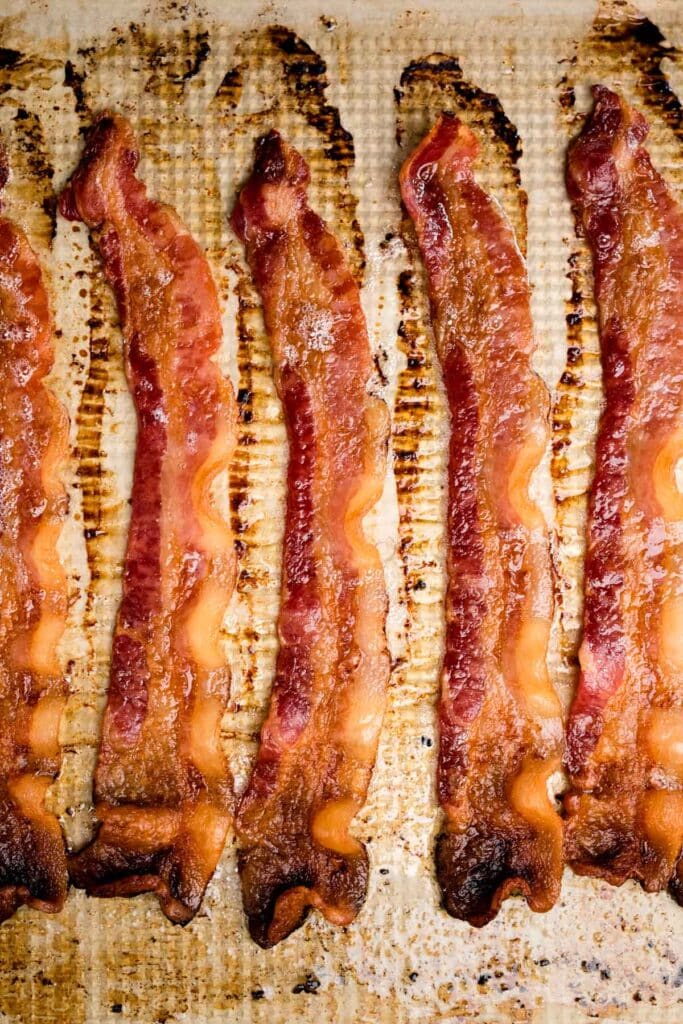
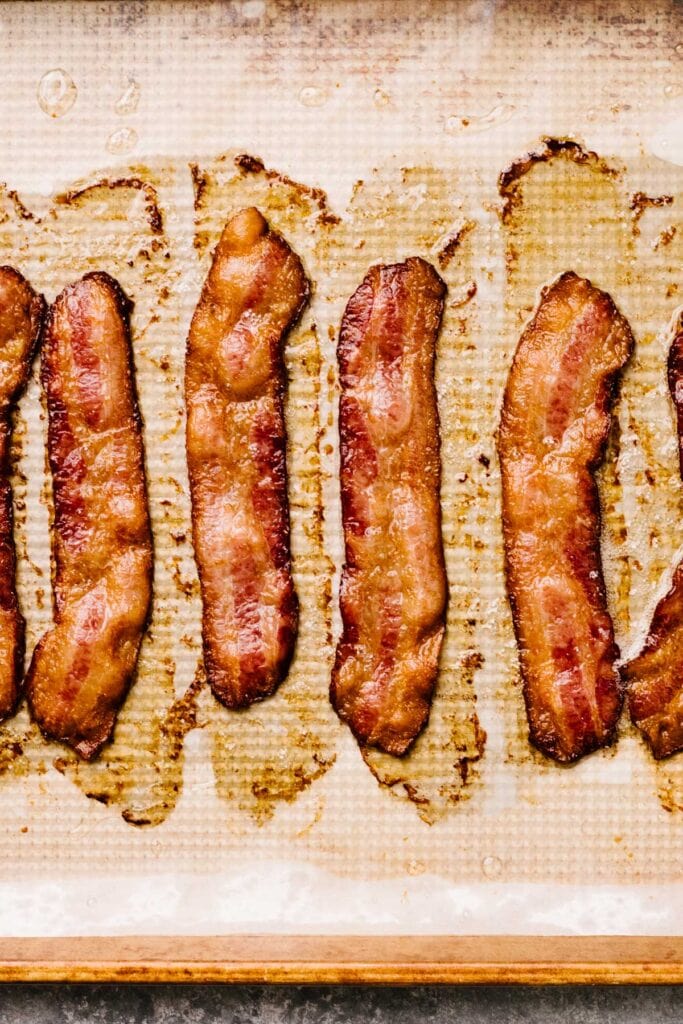
How to Cook Bacon in the Oven
This isn’t so much the best bacon recipe ever, as it is the best bacon preparation. It’s so easy to cook bacon in the oven – just line a baking sheet, arrange your slices, and pop it in the oven before heating. Be sure to flip once halfway through. Cook to your preference for chewy or crispy bacon.
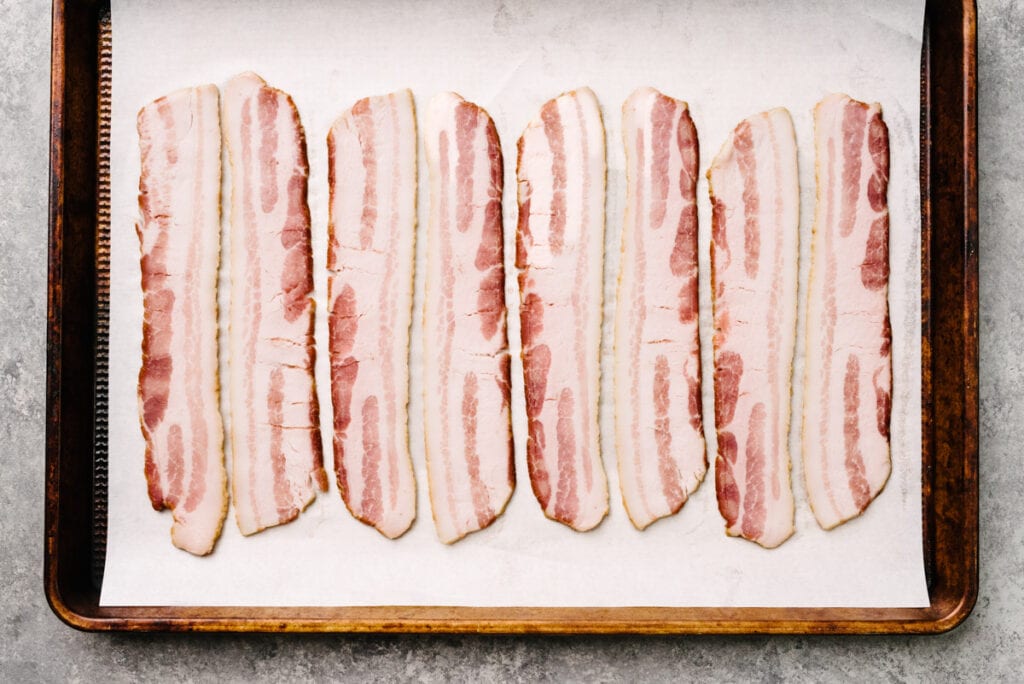
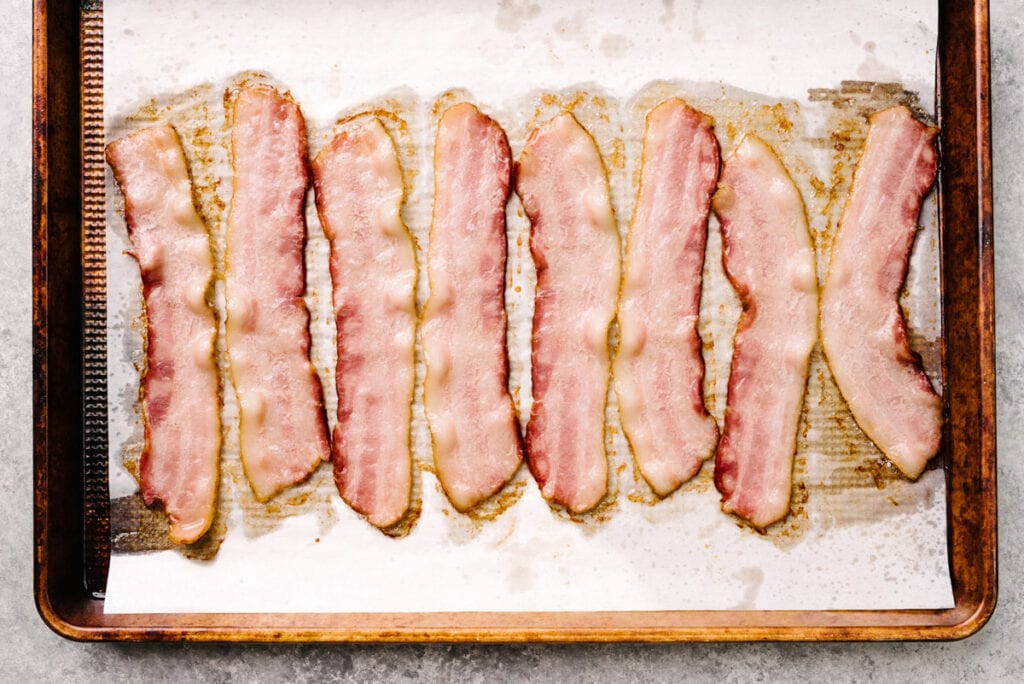
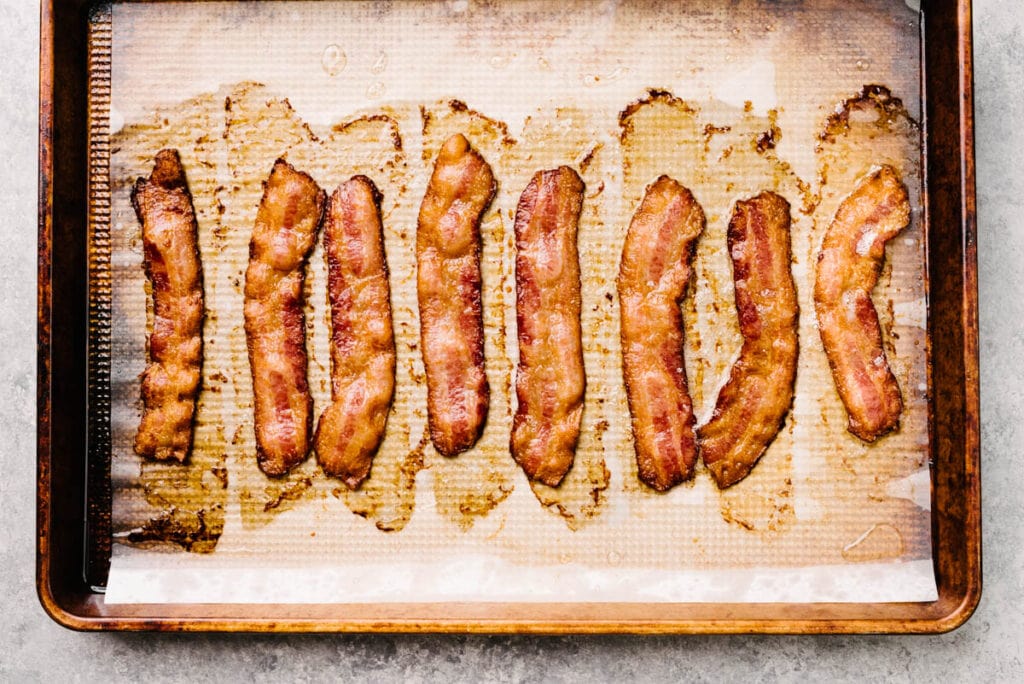
I prefer very crispy bacon, and cook the full additional 10 minutes. My husband and son prefer their bacon just a bit softer, and I pull slices out for them after 6-7 minutes.
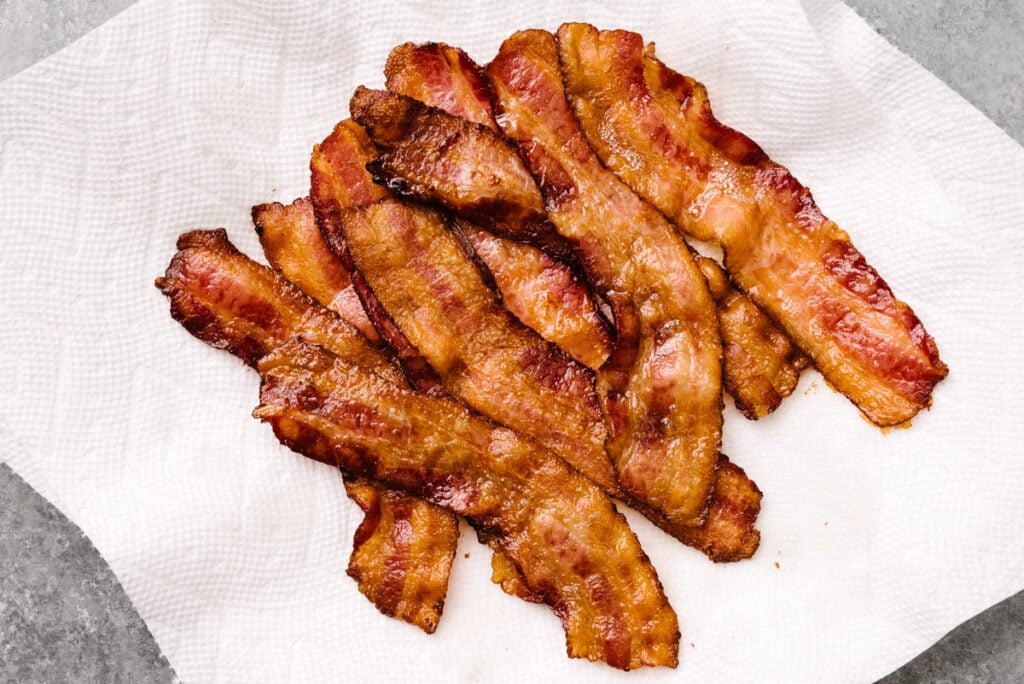
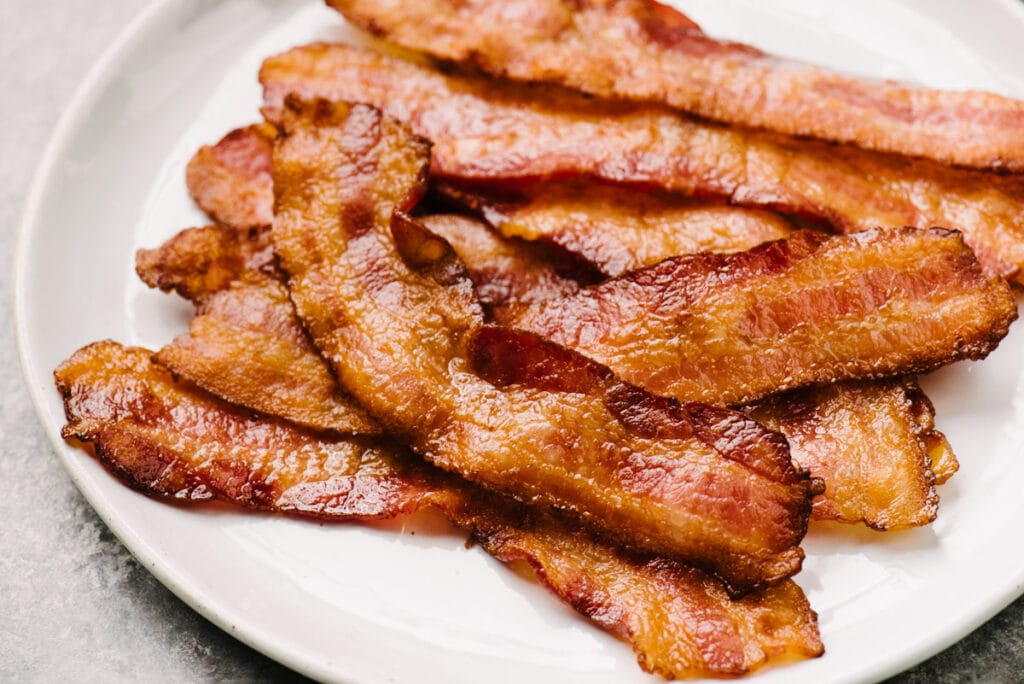
Chef’s Tips!
- Skip the baking rack in the pan. Starting the bacon in a COLD oven is the best way to ensure even crispiness throughout.
- But DO line your baking sheet with parchment paper or foil for easier clean-up.
- Arrange as many pieces as will comfortably fit on your baking sheet in a single, even layer. It’s okay if some of the pieces are touching, but don’t overlap them.
- Flip the bacon over halfway through cooking.
- When returning the bacon to the oven, rotate the pan 180° so the opposite side of the baking sheet now faces the door.
- For an even larger batch, use two baking sheets on two oven racks. When you flip the bacon halfway through, also swap the rack positions of the pans.
What Kind of Bacon Should I Use?
Let’s talk bacon basics before we really dig in to bacon choices.
What Is Bacon?
First, to clear up any confusion, all bacon is pork belly, but not all pork belly is bacon. In the U.S., most (pork) bacon is made by curing, then smoking, pork belly. While curing originated as a means of food preservation, it also has the delightful side effect of making things extra delicious and salty.
Cured Vs. Uncured Bacon
Now, I know what you’re thinking and yes, even if your bacon says it’s “uncured,” it’s still cured. The label just means it’s not cured with synthetic nitrites. Nitrite-free or “uncured” bacon still uses natural sea salt along with other organic ingredients that have naturally occurring nitrites.
We prefer uncured bacon. Perhaps, if cured bacon tasted even twice as good as uncured bacon, I MIGHT consider ignoring that there are some health risks associated with nitrites. Since they are both equally salty and delicious, why gamble?
Speaking of gambles, when choosing bacon don’t assume because it’s cured, it’s automatically safe or good. Straight from the USDA‘s mouth, “When buying bacon, look for slices with long veins of lean pink meat and a relatively small amount of fat.” Always check expiration dates.
Regular vs. Center Cut vs. Thick Cut Bacon
Now that’s all out of the way, you can think about what kind of bacon you want. Regular bacon (including center cut) is sliced thinner and will cook faster. Center cut will cook even quicker than regular because the fatty ends have been trimmed. Thick-cut bacon is, you guessed it, thicker! It’s typically double the thickness of standard bacon and will take slightly longer to cook.
- If you prefer crisp bacon, opt for regular/standard or center cut bacon.
- If you want your bacon to have a bit more chew to it, opt for thick cut. Just know you’ll have to cook it longer to render more of the fat down.
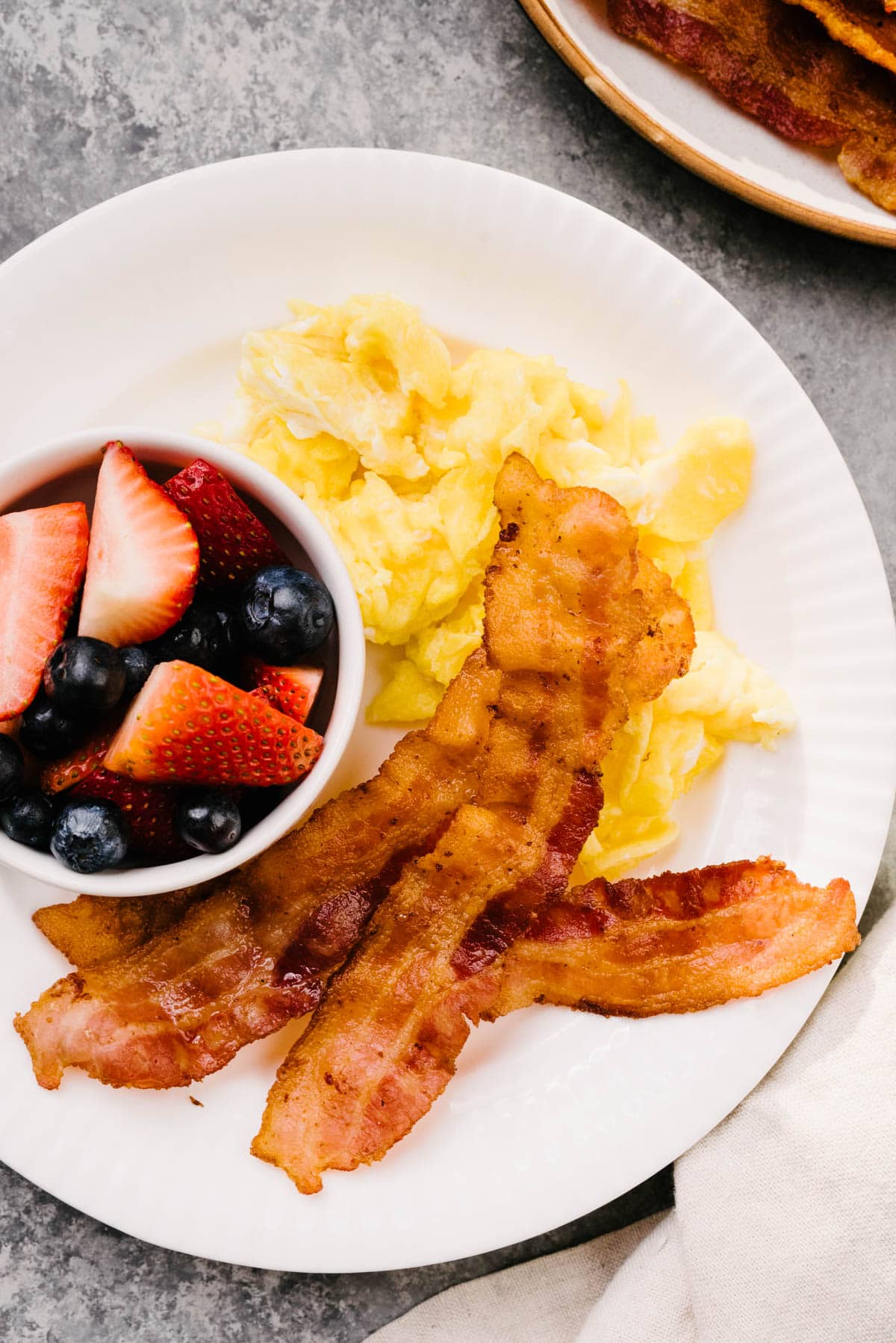
How Long to Cook Bacon in the Oven
Regular sliced bacon: cook 18-22 minutes, depending on how crisp you like it – 22 minutes yields perfectly crisp bacon. Cook for 12 minutes, then flip the bacon and return to the oven for another 6-10 minutes.
Thick cut bacon: thick cut bacon is not really ever going to get as crisp as regular bacon, so if you want crunch, reach for the regular. That said, cook 20-24 minutes – 24 minutes will yield nice, crisp edges with meaty middles. Cook for 14 minutes, then flip the bacon and return to the oven for another 6-10 minutes.
Turkey bacon: the low fat content is going to make turkey bacon cook even quicker than regular bacon. Cook for 15-17 minutes. Flip your turkey bacon after 10 minutes and cook for an additional 5-7 minutes depending on your preference.
More Bacon Recipes!
The best bacon “recipe” is the one that ends with you simply shoving it directly into your mouth-hole, unadulterated, but since bacon makes everything better, there is no wrong way to enjoy it.
The next best ways to enjoy bacon are arguably the classic BLT or classic bacon and eggs, but I say “Why settle for one?” Our breakfast BLT and fried green tomato BLT sandwiches celebrate the best of both bacon worlds. If you want to walk on the healthier side, we’ve also got a BLT salad and a Whole30 BLT chicken salad!
Another reason we love oven bacon is that it’s great for breaking up into pieces to use as garnish or as a mix-in (trust me, these ain’t little pixie dust-sized bacon crumbles). These homemade bacon chunks will keep for about 5 days in the fridge and there’s no shortage of recipes you can use them in.
- Use in party-perfect dips and spreads like jalapeno popper dip and smoky bacon guacamole.
- Make a better breakfast by mixing bacon pieces into sweet potato hash or our favorite holiday breakfast “mashup,” leftover mashed potato waffles.
- Load up your baked potatoes, from the classic side to the classic soup.
- And speaking of classics, it’s an unbeatable salad topper. Leafy greens love it, but give it a try with broccoli salad, bacon coleslaw, or Brussels sprouts salad.
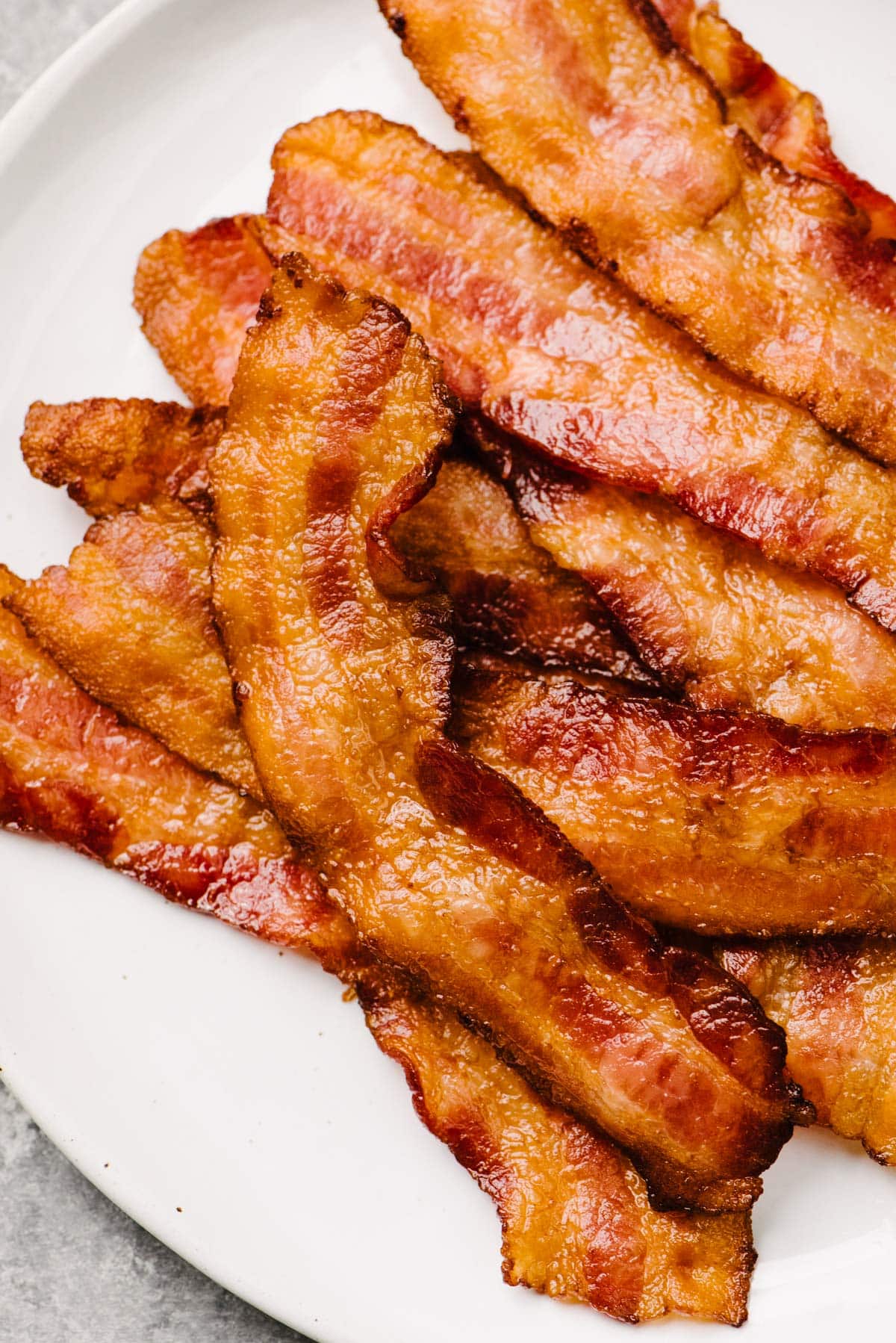
Did you make try our method for crispy oven baked bacon? I’d love to know how it turned out! Leave a comment and a rating below.
While you’re at it, let’s be friends – follow me on Pinterest and Instagram for the latest and greatest.
Recipe
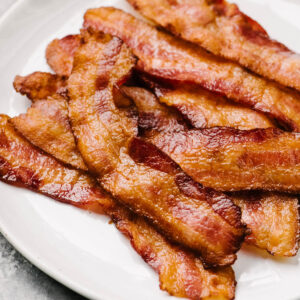
How to Cook Bacon In The Oven
Print Recipe Rate this Recipe Pin RecipeRecommended Equipment
Ingredients
- 8 slices bacon, regular, center cut, or thick cut
Instructions
- Line a baking sheet with parchment paper. Arrange the bacon on the baking sheet in a single, even layer. It's okay if some slices touch, but do not overlap. Arrange the slices flat.
- Postion a rack in the center of the oven, then place the baking sheet on the rack. Heat the oven to 400°F. Cook the bacon for 12 minutes.
- After 12 minutes, the oven should be fully heated and the bacon should be starting to render its fat. Remove the baking sheet from the oven and flip over each slice using tongs. Rotate the pan 180° (so the back now faces the front) and return it to the oven.
- Bake 6-10 minutes longer, or until the desired level of crispiness is reached. A full 10 minutes will yield evenly crispy strips with few soft bites; 6 minutes will yield bacon with uniformly crispy edges and softer centers.
- Remove from the oven and transfer the cooked bacon to the paper towel lined plate. Drain several minutes, and if desired, pat the tops of the bacon with a second paper towel to remove additional grease.
- Serve, and enjoy!
Notes
- If your baking sheet is large enough, position as many as 10 slices of bacon on the pan. There is no need to adjust the cooking time.
- For even larger batches (16-20 slices), use 2 baking sheets. Arrange racks in the upper and lower third of the oven. After flipping over the bacon at the 12-minute mark, rotate the pans and swap positions. You may need to add 1-2 minutes to the total cook time depending on how efficiently your oven distributes heat.


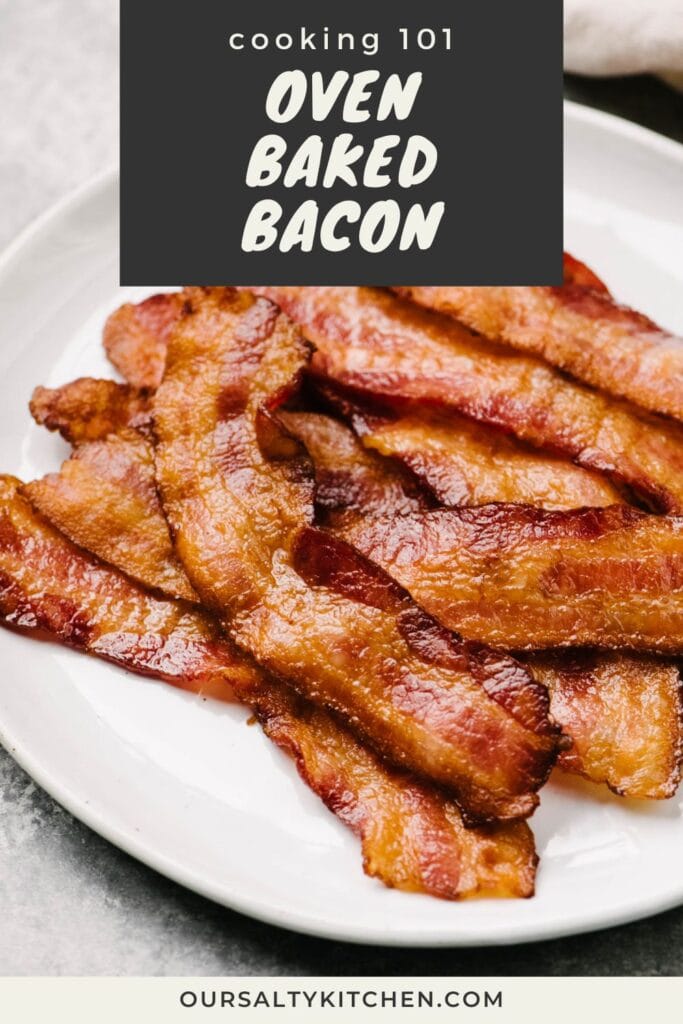
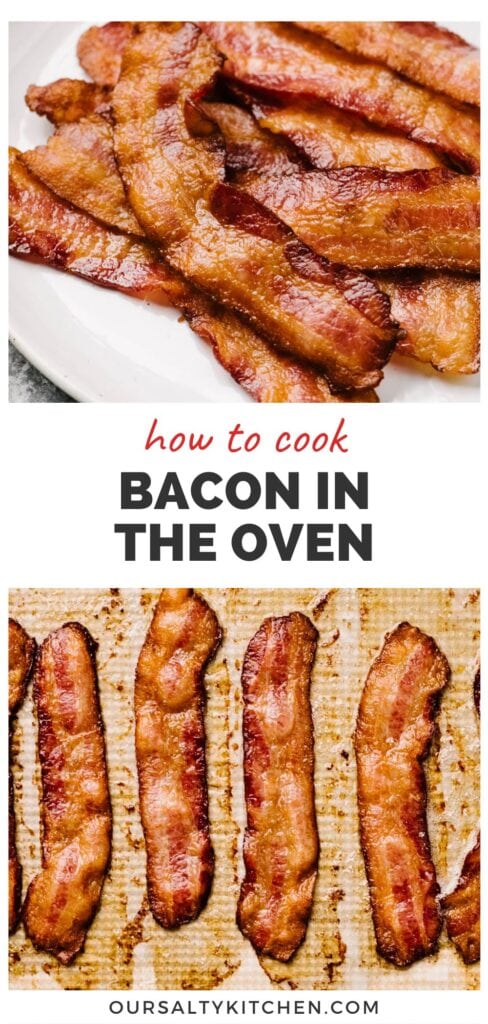
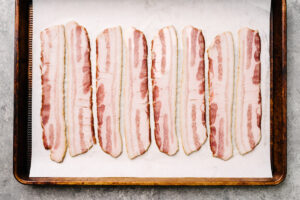
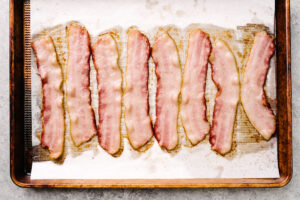

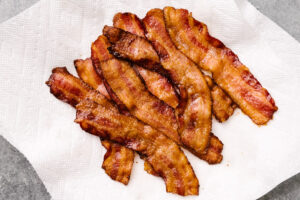
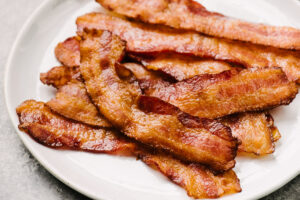

LUCYG
Okay, I’m in. BACON!! As if I needed an excuse.